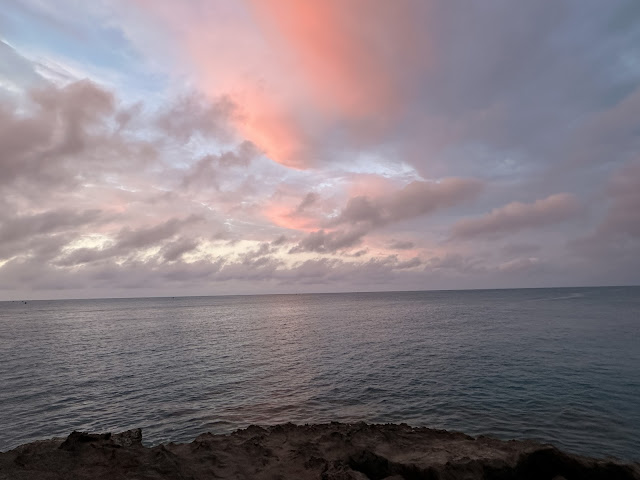 |
| Our Largest Team Yet! These shirts will never be this clean again... L to R: Emily, Ty, Sydney, Jay, Skyler, Collin, Ella, Xander, me, Rhiannon, Ewan, Juliana, Guillermo, Chloe, Charlie, Kaitlyn, Anjali |
Thanks to an NEH Archaeology Fieldwork Grant, SIAP has been able to mount the largest field season to date - 18 so far with a few more arriving in the week ahead and more than 20 Bermudians signed up to volunteer in the field and in the lab!
 |
Composite GIS image showing grid units, excavated features and
ground penetrating radar imagery of subsurface anomalies (top) |
This huge turnout is vital because we are focused on identifying as much of Governor Richard Moore's 1612 town as possible in a few short weeks. The
Plough brought between fifty and sixty settlers to Bermuda in July 1612 to inaugurate the island's deliberate colonization and to house this population Moore likely built a minimum of ten public buildings and private houses in a very short span of time. While in past seasons we have uncovered many lines of post holes (the footprints of timber-framed earth-fast buildings) we have yet to fully reveal an individual structure. Guided by Ground Penetrating Radar surveying and previously uncovered feature patterns, we hope to reveal at least two early settler homes in their entirety.
It has been a hectic week and a half gathering people from the airport and getting them "home" to Paget Island, moving gear to the camp and the Smith's Island sites, buying vast amounts of groceries, gathering work boats, clearing the Smallpox Bay site, and making sure noting goes wrong (as much as possible).
We have had tremendous support from generous Bermudians who have answered various calls in the RG and through the BNT for resources, especially
Bill Tatem and
Jack Bridges of Island Boat Club and BAMZ for the loan of work boats, which are absolutely necessary for a team this large.

Pembroke Paint and Mark Orchard gave us 25 new buckets for excavations, which will become well used by July.

Rhiannon our Lab Supervisor has been imposing order on the BNT Archaeology Lab at the Globe Museum in St. George's. Xander and Sam and Peter all helped with airport pickups while Peter Drew deployed a truly scary Vegetation Eating Machine to mow the SPB site flat in two hours (vs. taking two days to do it by hand).


Andre, the caretaker at Paget Island, has been his usual awesome self at helping us settle in and get oriented to our island home. Our quick start is entirely thanks to all these wonderful supporters!

 This year's team is gathered from all over - Rochester, Ireland, Durham, London, Southampton, Nevada, NC, Bama, NYC, Buffalo, Florida, Columbia, Amish Country, Virginia - and with two Bermudian professional archaeologists as well! Many hands make light work and we've already excavated 14 units in our first three days. A few have never been outside the US and many don't have much experience traveling by boat but they are an adventurous lot and getting used to our amphibious way of life.
This year's team is gathered from all over - Rochester, Ireland, Durham, London, Southampton, Nevada, NC, Bama, NYC, Buffalo, Florida, Columbia, Amish Country, Virginia - and with two Bermudian professional archaeologists as well! Many hands make light work and we've already excavated 14 units in our first three days. A few have never been outside the US and many don't have much experience traveling by boat but they are an adventurous lot and getting used to our amphibious way of life.

We also have two research specialists out with us for the first weeks. UR Mech Engineer Charlie is continuing his investigations of 17th-century Bermuda daub by sourcing materials at Smith's Island to attempt experimental reconstitutions of 1612 building techniques. By examining the daub recovered from the pit last summer as well as mortar and daub samples found in the destruction layer of the c. 1615-1640 Oven site kitchen, Charlie will decipher the core components in early daub formulations. He and Larry Mills hope to do a modest lime burn in the next few days (the first in decades I believe) to replicate the quicklime/wood ash mixture that the earliest settlers used. The final step will be to mix this and sand together proportionally to make new "old" daub that looks and performs like our archaeologically recovered material.

Meanwhile, UR Digital Humanities PhD Katie will be testing a multispectral image drone out west in Southampton to survey a thickly wooded area (High Point) with the hopes of revealing potential archaeological sites hiding in the forest. Aerial photography has long been used to spot buried sites from above but we hope that by adding the UV and IR bands we may detect subtle anomalies invisible in the normal light spectrum - details such as variants in vegetation health and moisture reflecting their growth over buried features and differential surface heating in the hour or two after sunrise (where large concentrations of shallow buried stone/foundations would remain cooler for longer than the soil around it). By comparing multiple series of the same area at different times of day, we hope to tease out new ways to detect cultural heritage elements across the centuries that would otherwise evade detection.
Today is a well-deserved day off. The digging weather has been more like late June than late May compared to past seasons so it is hard going, but spirits are high and Bermudian volunteers start to rotate in tomorrow!

















.jpg)
Comments